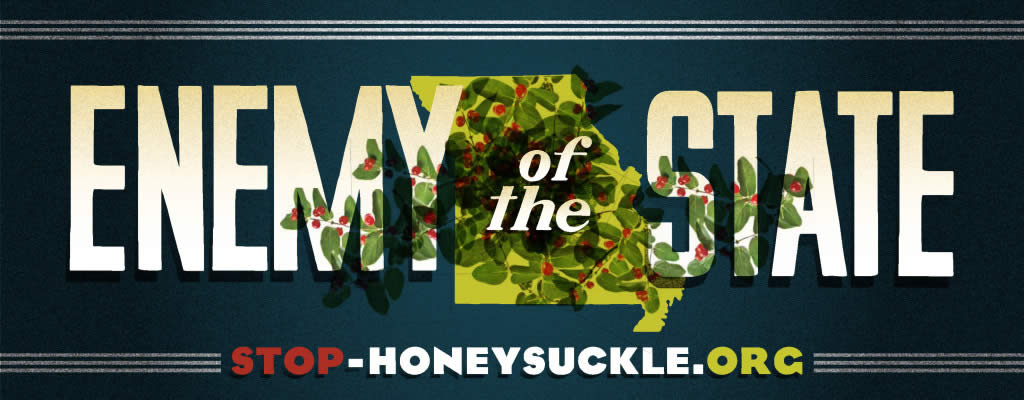
Bush Honeysuckle: Enemy of the State. Does that sound dramatic? That's the tone taken by a current state-wide campaign in Missouri to spur property owners to eradicate bush honeysuckle encroaching on their property. You may have seen one of the billboards along I-70. Hopefully it works!
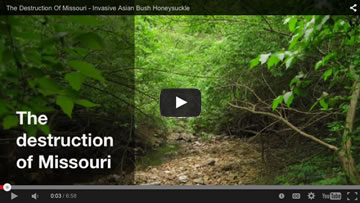 And check out their video: Whoa! A little drama may be needed to call people to action. The unique natural heritage of Missouri is indeed at risk. (Not to mention the eastern quarter of Kansas.) We've seen the effects honeysuckle can have in Roanoke Park and many other KC metro area parks and natural areas. Areas that have been severely infested by bush honeysuckle have their biodiversity greatly reduced and their native plants crowded out. Tree seedlings, especially of oak trees, have a hard time getting started under the dense shade of the pervasive honeysuckle thickets. Spring ephemeral wildflowers are killed out. Add a ground cover of purple wintercreeper (from China) and the environmental damage is multiplied. Without the native plants, shrubs and trees as host plants for caterpillars, birds have much less to feed their young. See BringingNatureHome.net to learn all about the vital role native plants play in our local environment, ie, your back yard. It's bad out there folks, but with a little effort we can turn the tide. Not just by cutting honeysuckle and wintercreeper, but by planting the native plants, shrubs and trees that they're crowding out. Not just in the park, but in your home garden and any other land you manage. See The Living Landscape for inspiration.
And check out their video: Whoa! A little drama may be needed to call people to action. The unique natural heritage of Missouri is indeed at risk. (Not to mention the eastern quarter of Kansas.) We've seen the effects honeysuckle can have in Roanoke Park and many other KC metro area parks and natural areas. Areas that have been severely infested by bush honeysuckle have their biodiversity greatly reduced and their native plants crowded out. Tree seedlings, especially of oak trees, have a hard time getting started under the dense shade of the pervasive honeysuckle thickets. Spring ephemeral wildflowers are killed out. Add a ground cover of purple wintercreeper (from China) and the environmental damage is multiplied. Without the native plants, shrubs and trees as host plants for caterpillars, birds have much less to feed their young. See BringingNatureHome.net to learn all about the vital role native plants play in our local environment, ie, your back yard. It's bad out there folks, but with a little effort we can turn the tide. Not just by cutting honeysuckle and wintercreeper, but by planting the native plants, shrubs and trees that they're crowding out. Not just in the park, but in your home garden and any other land you manage. See The Living Landscape for inspiration.
We have more information on this site about Bush Honeysuckle.
None of this is news to the neighbors cutting bush honeysuckle from Roanoke Park. Obviously we whole-heartedly endorse the campaign Stop-Honeysuckle.org.
Please visit stop-honeysuckle.org to learn more.
Beneath Roanoke Park's 12' high layer of bush honeysuckle were found many patches, in some cases a continuous carpet, of Wintercreeper (Euonymus fortunei).
“What's wrong with that?” some said. “Wintercreeper is green all year.” It's “good ground cover.” WRONG.
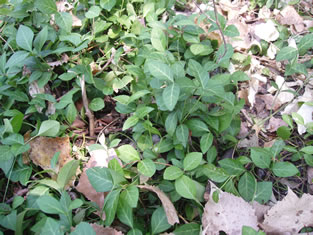 Click for a gallery of wintercreeper images.The problem is that wintercreeper outcompetes All native plants. ie, where wintercreeper lives, native plants die. Trees do not thrive. Without a wide variety of native plants and trees, our local insects, birds and animals cannot find the food and shelter they need to SURVIVE. Since wintercreeper and bush honeysuckle inhibit the regeneration of native plants and trees, they eventually form a monoculture and for local fauna, a food desert. Spring ephemeral wildflowers are completely killed out where wintercreeper and bush honeysuckle rule.
Click for a gallery of wintercreeper images.The problem is that wintercreeper outcompetes All native plants. ie, where wintercreeper lives, native plants die. Trees do not thrive. Without a wide variety of native plants and trees, our local insects, birds and animals cannot find the food and shelter they need to SURVIVE. Since wintercreeper and bush honeysuckle inhibit the regeneration of native plants and trees, they eventually form a monoculture and for local fauna, a food desert. Spring ephemeral wildflowers are completely killed out where wintercreeper and bush honeysuckle rule.
The goal of Roanoke Park's Ecological Restoration Plan is to maximize the ecological richness of the slopes of Roanoke Park for the benefit of park visitors and neighbors. Foreign invasive plants such as wintercreeper and bush honeysuckle are incompatible with that goal since they degrade diversity and inhibit the woods' natural self regeneration.
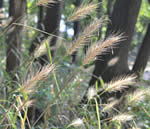 Canada Wildrye on the "Valentine Slope."Park volunteers have attacked the wintercreeper in targeted areas, but the efforts have not kept pace with this aggressively spreading invasive plant. Much more remains to be pushed back and ultimately replaced, an endeavor sure to take many years. Yet within Kansas City there are models for success and reasons for hope IF WE GET SERIOUS. The Shirling Sanctuary within Swope park has been restored to better health (and more birds) by the Burroughs Audubon Society: https://www.facebook.com/AudubonKC/posts/731732742335745
Canada Wildrye on the "Valentine Slope."Park volunteers have attacked the wintercreeper in targeted areas, but the efforts have not kept pace with this aggressively spreading invasive plant. Much more remains to be pushed back and ultimately replaced, an endeavor sure to take many years. Yet within Kansas City there are models for success and reasons for hope IF WE GET SERIOUS. The Shirling Sanctuary within Swope park has been restored to better health (and more birds) by the Burroughs Audubon Society: https://www.facebook.com/AudubonKC/posts/731732742335745
In the home landescape setting, wintercreeper is only "evil" when allowed to run wild. If you have some on your property and you're keeping it trimmed and in check (preferably in an area bounded by edging or concrete), that's fine. Kudos to you for responsible wintercreeper ownership. But if you allow it to "creep" off your property, or if you allow it to grow up your trees and produce berries, Your Wintercreeper Is Doing Harm. Birds are eating the berries and bombing seeds into the park and neighboring properties. Do your neighbors and the environment a favor and cut all wintercreeper growing up trees or other vertical surfaces.
Professional Advice Against Wintercreeper, from Local to National
Alan Branhagen - Powell Gardens former Director of Horticulture.
Wintercreeper rated "#1 - severe pest"
Invasive Plants of Greater KC -Powell 2014.pdf
Larry Rizzo - Cofounder of Kansas City Wildlands, MDC Natural History Biologist (retired), Biologist with Habitat Architects.
"Wintercreeper is probably the one species that is arguably worse than honeysuckle." - personal correspondence.
“Go to Cave Spring (Historic Site) at Blue Ridge and Gregory and take a look at the woods,” Rizzo said. “It’s our version of kudzu.” - 2010 Kansas City Star article
Missouri Invasive Plant Council
A top 25 invasive plant and causing "severe environmental degredation."
https://moinvasives.org/project/wintercreeper-climbing-euonymus/
To Be Banned in Missouri?
Euonymus fortuei is included in bills advancing in the Missouri House and Senate in the spring of 2024.
https://moinvasives.org/2024/03/08/hb-2412-sb-1281/
Missouri Botanical Garden - "Midwest Noxious Weed: Do Not Plant"
https://www.missouribotanicalgarden.org/PlantFinder/PlantFinderDetails.aspx?taxonid=368044&isprofile=1&basic=Euonymus%20fortunei
Washington University - Invasive Plants of Missouri
https://sites.wustl.edu/monh/invasive-plants-of-missouri/
Leitzeger Road Ecology Center (St. Louis area)
www.litzsinger.org/research/carpenter.pdf
Research showing increased numbers and variety of tree seedlings/saplings in areas where wintercreeper and shrub honeysuckle were being managed against versus an unmanaged control area.
St. Louis Audubon Society - Bring Conservation Home program
https://sites.google.com/stlouisaudubon.org/stl-naturescaping-info-hub/bring-conservation-home-certification/residential-certification
Silver Level - Wintercreeper removed from all vertical surfaces
Platinum Level - 100% wintercreeper removed
Missouri Dept. of Conservation - "Invasive. ...heavy infestations in woodlands around St. Louis and Kansas City."
https://nature.mdc.mo.gov/discover-nature/field-guide/wintercreeper
"Wintercreeper threatens native plants and natural habitats in open-to-shady and moist-to-dry locations. It can form a dense groundcover that reduces or eliminates native plant species. It depletes nutrients and moisture for native species and can smother and kill shrubs and trees."
https://mdc.mo.gov/trees-plants/invasive-plants/wintercreeper-control
"Wintercreeper can cover the ground and vegetation and eliminate native ground cover species in mesic and dry-mesic forests. It is a serious potential threat because it spreads so rapidly and replaces spring ephemerals. The Shirling Sanctuary in Kansas City's Swope Park provides an example of a mesic forest that has been seriously degraded by the aggressive spread of wintercreeper."
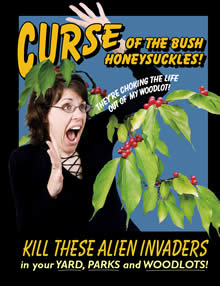 The main overgrowth of vegetation afflicting Roanoke Park is the non-native invasive bush honeysuckle* Lonicera maackii. This plant is native to Asia and was imported to our area as a landscape plant valued for it's fragrant spring honeysuckle blooms, fall red berries and utility as a screen. But alas, this plant has "escaped" with a vengeance, lining roadsides and invading parks and natural areas throughout Kansas City. Birds eat the berries and spread the plant near and far. Roanoke Park is not alone in suffering from an infestation but may be one of the spots where it can be effectively controlled with concerted effort. Control efforts are being undertaken in Hyde Park and Gillham Park and in parts of Swope Park and other properties where Kansas City Wildlands volunteers are at work. Homeowners and property owners are encouraged to remove it from their properties if at all possible.
The main overgrowth of vegetation afflicting Roanoke Park is the non-native invasive bush honeysuckle* Lonicera maackii. This plant is native to Asia and was imported to our area as a landscape plant valued for it's fragrant spring honeysuckle blooms, fall red berries and utility as a screen. But alas, this plant has "escaped" with a vengeance, lining roadsides and invading parks and natural areas throughout Kansas City. Birds eat the berries and spread the plant near and far. Roanoke Park is not alone in suffering from an infestation but may be one of the spots where it can be effectively controlled with concerted effort. Control efforts are being undertaken in Hyde Park and Gillham Park and in parts of Swope Park and other properties where Kansas City Wildlands volunteers are at work. Homeowners and property owners are encouraged to remove it from their properties if at all possible.
Bush honeysuckle is detailed further in this excellent publication from the Missouri Department of Conservation: Curse of the Bush Honeysuckles! Identification and control measures are discussed and many suitable landscape alternatives are shown.
ABOUT THE "JUICE" THAT DETERS REGROWTH
For controlling unwanted bush honeysuckle (Lonicera maackii) via cut surface treatments in forests. Tordon is selected for this project because it is shown to be effective and only requires a small dab applied sparingly and directly to to the freshly cut stem. Download Applying_Tordon_RTU.pdf for specific application instructions and illustrations as used by Kansas City Wildlands.
- Paint RING of Tordon within minutes of cutting honeysuckle stalks.
- Treat every cut stalk—the bush will re-emerge with great vigor through any untreated stem.
- Work in teams of three: one cutter, one brush dragger, one Tordon treater.
- To avoid missing any cut plants, the cutter should not move on until seeing that the treater is at work on the just cut plant.
Avoid contact with skin, eyes or clothing!
Roanoke Park News & Events
TRAIL INFO
Trail Maps, in various formats:
Roanoke_Park_Trails.pdf (417 kb).
Roanoke Park Trees and Trails Google Map
"Roanoke Park Tour" on MTBProject.com
To avoid damaging trails, check Trail Status before biking or hiking off road. ("Rozarks" = Roanoke Park's 2.5 miles plus Rosedale's 3.5 miles.)
Contact the Westport-Roanoke Community Center to find out about their facilities or inquire about reserving spaces.

